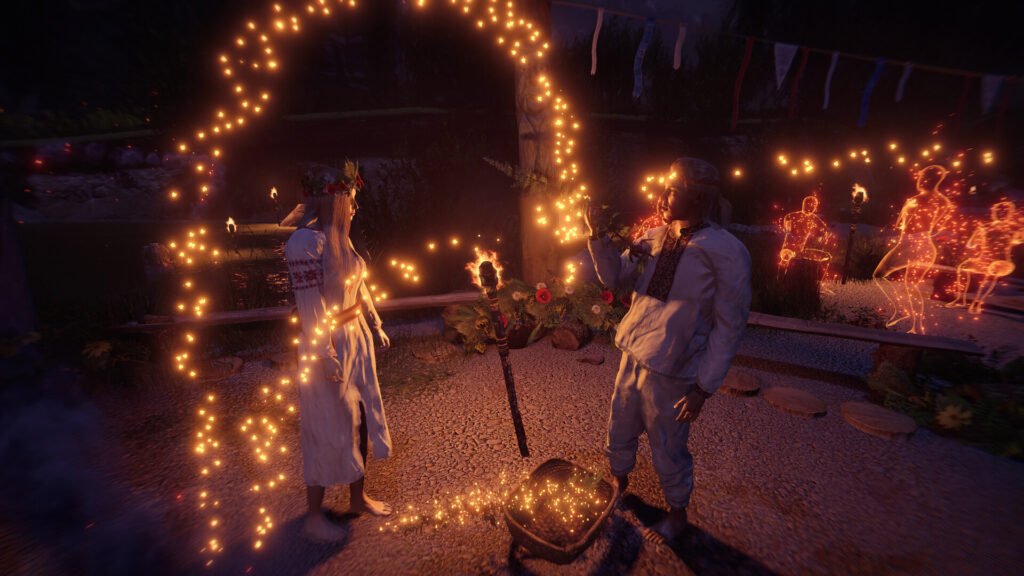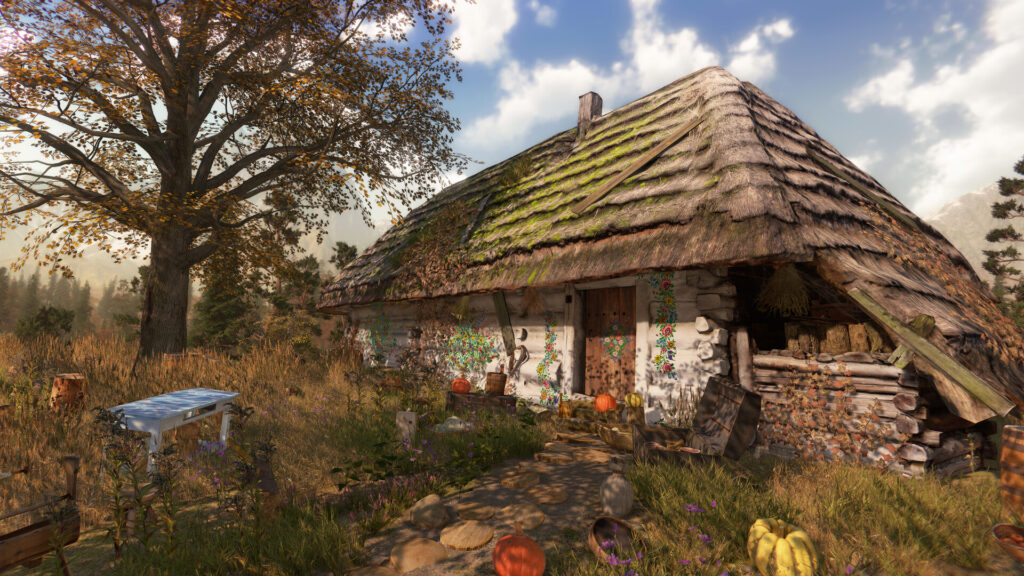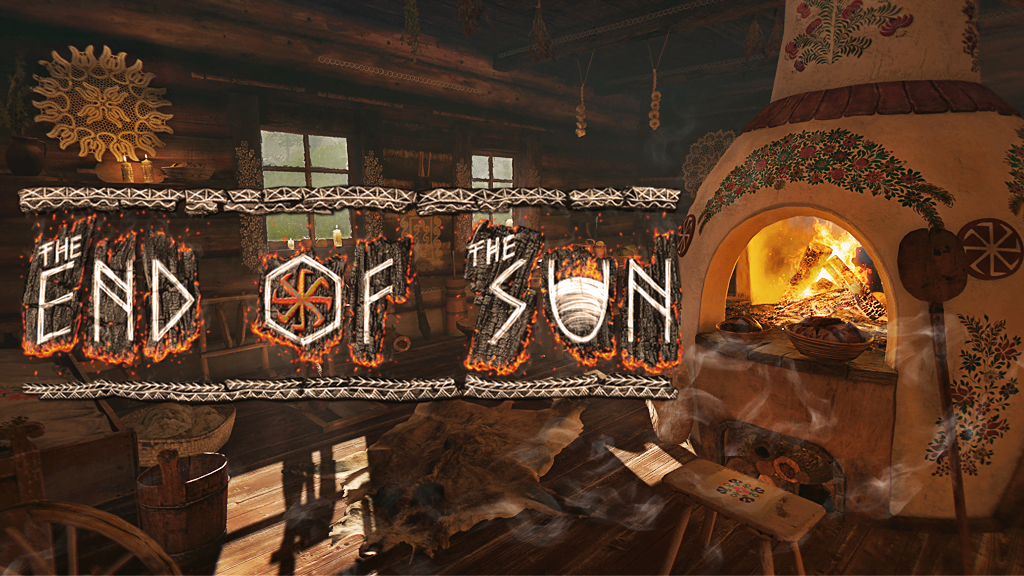A Time-Bending Tale Rooted in Slavic Folklore
The End of the Sun is a narrative-driven adventure game that transports players into the mystical world of Slavic mythology, blending folklore, mystery, and time manipulation into a captivating experience. Developed by The End of the Sun Team, this game is more than just an exploration of the past—it’s an emotional journey that unravels the fate of a village and the lives intertwined within it.
You step into the shoes of an Ashter, a gifted sorcerer-investigator with the ability to travel through time and manipulate past events. Your mission? Track down a magical creature that has been causing chaos in the countryside. But as the trail leads you to a seemingly deserted village, the real mystery begins. The only clues to what transpired lie in smoldering hearths scattered around the village—each serving as a portal to the past where you can witness and reconstruct pivotal moments.
The non-linear narrative, beautiful environments, and richly detailed world steeped in Slavic folklore create an experience that’s both thought-provoking and immersive. But does this slow-paced, contemplative journey resonate with all types of players? Let’s dive into the details.
Gameplay: Solving Mysteries Through Time and Seasons
At its core, The End of the Sun is a time-traveling adventure that encourages exploration and puzzle-solving. The central mechanic revolves around interacting with hearths—smoldering fires that allow you to relive and reconstruct past events.
Time-Travel Across Seasons
The game’s most intriguing feature is its season-hopping mechanic, where you can shift between the four seasons to observe how the village and its people change over time. What happens in one season impacts future events, adding a layer of cause-and-effect that makes exploration feel meaningful.
For example, actions you take during spring can alter the environment when you revisit the same location in winter, showcasing a dynamic, living world where past decisions have tangible consequences.
Nonlinear Exploration and Freedom
After an initial introduction, The End of the Sun grants players the freedom to explore its world non-linearly. You can approach the story’s vignettes in any order, allowing for a personalized storytelling experience where each small tale gradually pieces together the larger mystery.
Puzzles That Fit the Narrative
The puzzles in The End of the Sun feel organic, as they seamlessly blend with the world and its story. Whether it’s reconstructing memories, gathering objects to complete vignettes, or solving environmental challenges, each puzzle feels like a natural extension of the narrative rather than an arbitrary obstacle.
However, some puzzles can feel a bit tedious or repetitive, especially when tied to tracking down objects or revisiting the same locations multiple times across different seasons.

Story and World-Building: A Deep Dive into Slavic Culture
The beating heart of The End of the Sun lies in its deeply engaging narrative and the rich culture it draws upon. The game doesn’t just tell a story—it immerses players in Slavic traditions, folklore, and history.
A Tale of Magic, Family, and Fate
The game’s plot follows the unraveling of a family’s history, intertwined with mythical creatures and ancient beliefs. Through the vignettes unlocked by the hearths, you witness moments from the villagers’ lives and gradually uncover how their fates are tied to the magical creature you’re pursuing.
The narrative unfolds like a historical puzzle, where each piece adds nuance to the overarching mystery. This layered storytelling keeps you engaged as you work toward understanding the village’s tragic past.
Authenticity in Every Detail
What sets The End of the Sun apart is the meticulous recreation of Slavic architecture, clothing, and artifacts. The developers scanned real-world props and structures to ensure authenticity, making the village feel genuinely alive and historically grounded.
Every corner of the world feels lived-in and rich with history—from wooden cottages to ancient rituals. Exploring the environment offers not only clues to the narrative but also fascinating insights into Slavic culture, making it an educational journey as much as an adventure.

Visuals and Audio: An Ethereal, Immersive Atmosphere
The End of the Sun excels in creating an atmospheric and visually stunning world that feels like stepping into a painting inspired by Slavic mythology.
Seasons That Breathe Life into the World
The changing seasons aren’t just a gameplay mechanic—they’re a visual storytelling device. Each season alters the landscape dramatically, from the lush vibrancy of spring to the stark desolation of winter, adding an emotional weight to your exploration.
As you revisit the same locations across different seasons, the attention to detail ensures that even familiar places feel new and dynamic.
Soundtrack and Voice Acting
The game’s soundtrack is another standout element. Inspired by traditional Slavic melodies, the music infuses the game with a sense of mysticism and wonder. From haunting chants to ethereal ambient tracks, the music enhances the emotional weight of each vignette.
Voice acting is available in both English and Polish, though many players may prefer the Polish voiceovers for a more authentic and immersive experience. Subtitles allow players to follow along without losing any narrative depth.

Where The End of the Sun Shines and Where It Falters
Strengths That Make the Journey Memorable
✔️ Engaging, Nonlinear Storytelling – The freedom to explore vignettes in any order adds a sense of personal agency to uncovering the mystery.
✔️ Authentic Slavic Cultural Representation – The game’s dedication to realism makes the world feel historically rich and culturally immersive.
✔️ Visually Stunning Seasonal Transitions – The changing seasons breathe life into the world, making exploration feel rewarding and dynamic.
✔️ Atmospheric Sound Design and Music – The haunting soundtrack blends perfectly with the game’s ethereal narrative.
✔️ Thought-Provoking Puzzles Tied to Storytelling – The puzzles add to the narrative without feeling forced or artificial.
Challenges That Might Break the Immersion
❗ Pacing May Be Too Slow for Some Players – The slow, methodical pace may deter players seeking more action or high-stakes gameplay.
❗ Limited Replayability – Once the full narrative unfolds, there’s little incentive to revisit the game, as the outcomes remain the same.
❗ Occasional Confusion in Objectives – The game’s nonlinear structure and limited handholding can leave players feeling directionless at times.
❗ Repetitive Puzzle Design – While the puzzles fit thematically, some may feel repetitive or drag on longer than necessary.
The End of the Sun: The End of the Sun is not a traditional game—it’s an immersive narrative experience that rewards patience, observation, and curiosity. Through its stunning visuals, haunting music, and engaging exploration of Slavic mythology, it crafts a world that feels both real and magical. However, its slow pace and lack of high-intensity gameplay may not appeal to everyone. For those who appreciate atmospheric storytelling, complex mysteries, and rich cultural immersion, The End of the Sun offers a journey worth taking. If you’re ready to step into the shoes of an Ashter and witness the past through fire and smoke, this game promises an unforgettable adventure filled with mystery, folklore, and wonder. – ColdMoon


